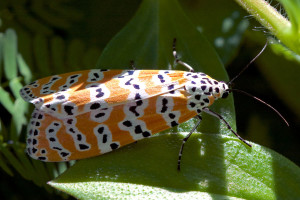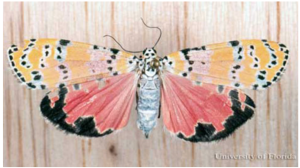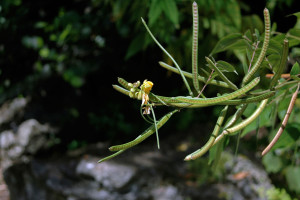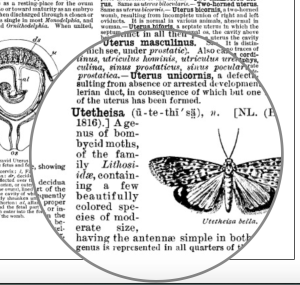The more I get to know my little patch of ground, the more exciting it is to find something new in it. In early October this year I found a species of moth called a Bella Moth (or Ornate Bella Moth), Utetheisa ornatrix. It’s a pretty little moth, with orange wings that bear white stripes with black dots in them. On its “shoulders” it bears a pretty white “shawl” with black polka dots:

It looks quite a bit more pink than orange in flight, because, like many moths, its underwings are of a different color than its upper wings. Unfortunately, since I didn’t have a dead moth, I was unable to get a shot of them, but here’s a screenshot of what they look like, from the UF/IFAS Featured Creatures website, photo by Don Hall (clicking the photo will take you to the UF/IFAS page about this moth; scroll down the page to Figure 6):

I was surprised to find this moth in my yard because I don’t have the host plant for it, which is any number of species of wildflower in the genus Crotalaria, called rattlebox for the way the seeds rattle in the seed pod.
Here’s a bad picture from my files of one species I saw back in 2008 at Fern Forest; you can see that it will bear yellow flowers and it has abundant seed pods (making this a rather weedy species):

It tends to grow in scrubby sites, and the closest scrub areas that I know about are several miles away. But it’s a weedy genus, and there must be some growing nearby that I don’t know about.
An alternative explanation for the presence of this moth in my yard comes from the Century Dictionary online, which defines this genus and uses U. bella (an older name for this same species) as the prototype:

Plants in the genus Myrica include the common Wax Myrtle, which I have in my back yard! So I’ll have to inspect my two shrubs for evidence of these larvae. Just for fun, here’s the beginning of the definition from the Century Dictionary:

Assuming this moth to be a stray, rather than one who grew up on the wax myrtle in my back yard, it probably had a formidable array of chemical defenses to protect itself from predators. It gets these chemicals from its most common host plants, the crotalarias. They have some very poisonous chemicals in their tissues to repel plant-eating critters. But, as Thomas Eisner wrote about in his book For Love of Insects, (I wrote a bit about that book a few years back in discussion of another new backyard insect) if a plant creates a defense, an insect can find a way around it. And that’s what these beautiful moths do.
Eisner devotes almost an entire chapter (chapter 10, “The Sweet Smell of Success”) of his book to the work he and his graduate students did on these moths at the Archibald Biological Station in Venus. Apparently it was a chance observation of this species of moth being freed from a spiderweb by the spider that “changed forever the way we [think] about insect survival” (349). This moth is distasteful to predators, which confers a huge survival advantage on it.
Their distastefulness derives from their diet: eating these crotalarias (in the pea family, but toxic enough to kill cows) enables them to absorb their defensive chemicals (in this case, pyrrolizidine alkaloids) and saturate their bodies with them, to the point where most predators, even naive1 ones, will leave them alone.
Interestingly, Eisner and colleagues discovered that the uptake of this chemical in the moth caterpillars is variable, and if a growing larva doesn’t have enough of it, it will resort to cannibalism to acquire it! Alkaloid-hungry caterpillars will leave alone their brethren who also don’t have the chemical, but should they encounter one that has it, they’ll do their best to eat it up!
The bella moth is a tiger moth, in the large and diverse subfamily Arctiinae. My etymological research has come up empty; the Century Dictionary is my fallback etymological source for insect names, and as you can see from the pictures in the post above, it didn’t bother to give an etymology, although it did source the name to Hübner, 1816. Here’s Wikipedia’s summary of the taxonomy:
In 1758, Carol Linnaeus first characterized two species of the genus Phalaena. Phalaena ornatrix was used to describe the paler moth specimens, and Utetheisa bella, described the bright pink moth specimens.[3] In 1819, Hübner moved these species to a new genus, Utetheisa.[4] For nearly a century, it was difficult to determine this moth’s evolutionary history as researchers focused on external similarities (color, shape, patterns, size), rather than determining features specific to the species. This led to great confusion when trying to categorize the different subspecies.[4] In 1960, Forbes combined both species, Utetheisa ornatrix and Utetheisa bella,into the species now known as Utetheisa ornatrix.[4] His conclusion was also supported by Pease Jr. who, in 1966, used genetic testing and determined that any phenotypic differences were based on interspecific variation due to geographic differences (rather than intraspecific variation).[4]
And here’s a beautiful picture of a slightly different color form of this moth from the island of Tobago:

For more on this moth, I highly recommend Donald Hall’s write-up on Featured Creatures (see References, below); his bibliography is stuffed with more technical references if you’re curious.
References
Century Dictionary online.
Eisner, T. 2003. For Love of Insects. Cambridge, MA: Belknap/Harvard.
Hall, D. 2005. common name: bella moth, rattlebox moth, inornate moth or calico moth
scientific name: Utetheisa ornatrix (Linnaeus) (Insecta: Lepidoptera: Erebidae: Arctiinae). From the Featured Creatures website, http://entnemdept.ufl.edu/creatures/beneficial/leps/bella_moth.htm
The dread Wikipedia. Utetheisa ornatrix. https://en.wikipedia.org/wiki/Utetheisa_ornatrix
